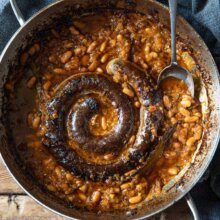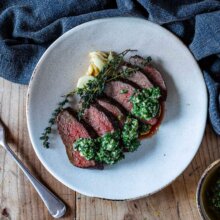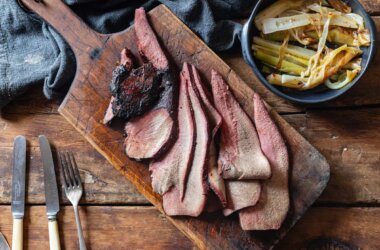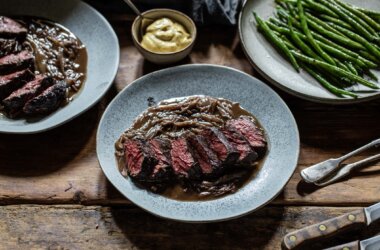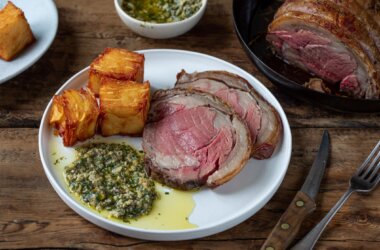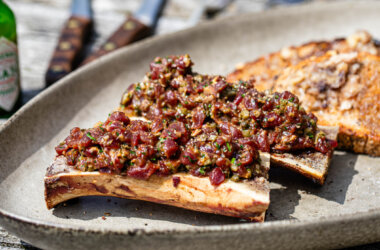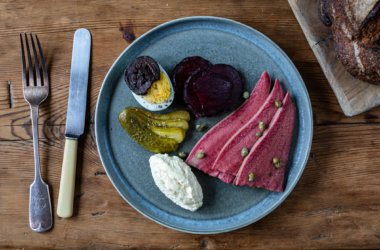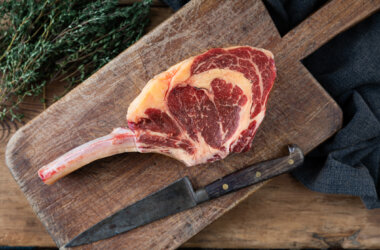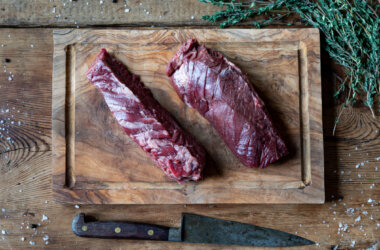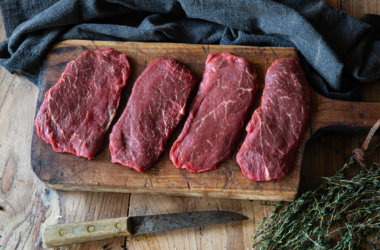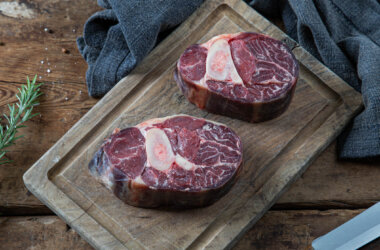
One of the great bistro steaks, this sharing-sized bavette steak, cooked to a perfect medium-rare and then rested with this brilliant compound butter melting over the top of it. Some triple-cooked chips on the side, and you’re winning!
For those that haven’t before cooked or eaten a bavette steak, you are in for a bit of a treat. With more texture than some of your prime steaks, two tricks to cooking and serving it must be followed. Firstly, either under or over-cooked and it is going to be tough, so aim for medium-rare and don’t miss. Secondly, it must be sliced against the grain.
Follow these rules, and you will enjoy a steak of depth and flavour, and with this Clarence Tavern Butter — made with slow-roasted tomatoes, bone marrow, softened shallots, tarragon, and green peppercorns, you have the perfect accompaniment. Those flavours, all underpinned by the depth and sweetness of the slow-roasted tomatoes, come together to add a little brio to your steak dinner, which is completely delicious.
Serves 2
Ingredients
Method
Start with the chips:
- Peel the potatoes and cut them into chips. I personally don’t like them too chunky, but this is a decision for you to make.
- Put the chips in a large pan and place the pan in your sink. Wash the chips in water from the hot tap, as hot as possible. Stir them around the pan as the water pours, and you will notice all the starch coming out of them. Wash like this for a couple of minutes.
- Then switch the water to cold and cover the chips. Season with sea salt and place over a high heat. Bring to a boil and then reduce slightly to a good simmer. Cook for 10-14 minutes — much will depend on the thickness of your chip. One of the tricks to a great chip is to be brave with the first blanching. Take them a little further than seems sensible.
- With care and a gentle touch, drain the chips into a colander and then transfer them to a tray to cool. It is best if they are in a single layer so they don’t get too smashed up. Leave them somewhere to cool completely.
- Heat your deep fryer, or a large pan with vegetable oil or beef dripping, to 130°C. In batches, so as not to overfill the fryer, fry off the chips for 6 minutes. Drain any excess oil and then lay on a tray to cool.
Cook the bavette next:
- Remove the bavette from the fridge and its packaging, and allow it to come up to room temperature.
- Season the bavette well with fine sea salt.
- Place a frying pan or cast-iron skillet over a high heat, with a splash of oil. Once the oil begins to smoke, carefully lay the bavette in the pan and allow to cook for 1 minute. Then flip and cook on the other side for 1 minute, so that good caramelisation forms on both sides.
- Reduce the heat to medium and add a large knob of butter to the pan. As the butter foams and begins to brown, begin to baste the steak generously. After 30 seconds, flip the steak and continue basting.
- Cook like this, flipping and basting every 30 seconds or so, over a low heat, for about 5-6 minutes.
- Remove the bavette from the pan, transfer it to a plate, and place the three discs of butter on top of the steak. The residual heat from the steak will gently soften the butter.
- Leave to rest for at least 10 minutes.
- For the third phase of the triple-cooked chips, turn the fryer up to 185°C and, again in batches, fry off the chips for 3-4 minutes. Drain off any excess oil and tip into a bowl lined with kitchen towel. Season well with sea salt.
- Transfer the steak to a chopping board and carve against the grain. Give the bavette a quick flash in an oven or under a grill (30 seconds or so), just to loosen the butter and give a little heat back to the steak.
- Whisk 2 teaspoons of Dijon mustard with 2 tablespoons of vinegar and a pinch of salt. Then whisk in 6 tablespoons of olive oil. Taste and adjust the seasoning as necessary. Dress the watercress liberally with the vinaigrette and serve immediately.
